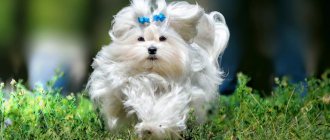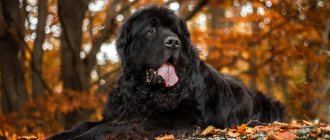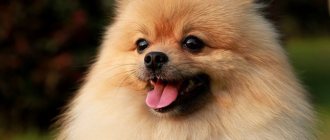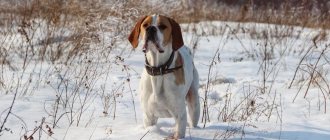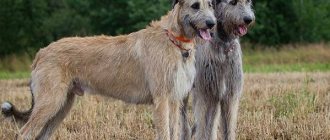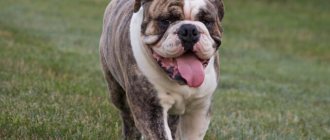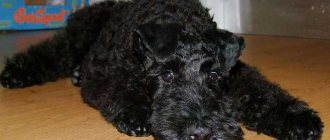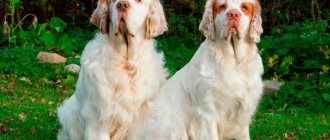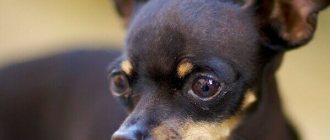| Origin: | Belgium |
| Usage: | companion |
| Color: | black, red, fawn |
| Dimensions: | height about 30 cm, weight 3.5-6 kg |
| Lifespan: | 13-14 years old |
The Petit Brabançon is a small decorative dog from the Griffon triad. Its closest relatives are the Belgian Griffon and the Brussels Griffon. All dogs descended from a common ancestor, but in the process of development they acquired different appearances. These animals are smart, friendly and loyal. Initially, the pets were bred to work in ports and as guards, but now they have become pets.
Description and features
The main purpose of the Petit Brabançon dog was to guard the royal crew. Having her in your home was honorable and prestigious. For many centuries this animal was considered a status animal. Few people know, but representatives of this breed are excellent rat catchers.
For many years they were trained on rats, possums and mice that gnawed through the walls and foundations of houses. Rodents have always caused trouble for humanity, so the need for their destruction has never gone away.
An ordinary domestic cat could solve the problem of raids by these animals, but only if their numbers were small. But a small but fast dog could easily fight a whole flock of tailed pests. This breed has 2 basic advantages - strong immunity and a balanced character. Such dogs rarely lose their temper, but at the same time they always maintain their dignity.
Some modern dog lovers get Petit Brabançons for hunting. Of course, it is useless to go after a wolf or wild boar with him, but he can easily catch a squirrel or a wood mouse. However, over the years, the dog’s hunting urges have somewhat dulled. Bloodthirstiness and aggression towards small animals awakens in him very rarely.
The birthplace of the animal is Belgium. It is believed that its ancestor was the Affenpinscher. Also, according to the popular version, he has mongrel genes. Such a dog has something human. Perhaps a confident walk or a meaningful look.
Most women keep her as an indoor (decorative) pet. You can see a hairpin or bow on the head of a Brabant Griffon female at any time of the year. Housewives idolize their calm and charming pets.
History of the Petit Brabançon breed
The distant ancestors of all griffons lived in Europe back in the 15th century.
As a result of interbreeding, Griffons have become the owners of two types of coat: the Brussels and Belgian can boast a rough coat, similar to the hair of an Irish terrier, and the Petit Brabançon has a smooth coat, reminiscent of a pug. One of the characteristic features of the Brabant Griffon is its upturned muzzle. The whole range of emotions can be easily read from her. The modern Petit Brabançon is a collective image that contains a little bit of different breeds. By the way, that very unique muzzle - short, slightly reminiscent of a monkey - was inherited from the German wire-haired Affenpinscher. But this little native of Brabant owes his elegant color to the Cavalier King Charles Spaniel.
The new breed so captivated aristocratic circles, especially crowned heads, that it quickly gained enormous popularity. Its representatives lived in palaces, slept on silk pillows, rode in carriages with their high-ranking masters, and even had their own servants. In those distant times, there was not even electricity, not to mention active pastime in our understanding, so the Petit Brabançons entertained their aristocratic owners for hours with fun games, and on cold nights they warmed them in their beds. The Brabant griffons were especially appreciated by single ladies who were disappointed in a strong field and had already despaired of ever finding love. Funny and always positive, these dogs added color to their lives. In addition, griffons left virtually no fur on expensive dresses.
It was soon noticed that Petit Brabançons have a “cat-like” hobby that is unusual for dogs - catching small rodents. From that moment on, the cheerful companions of single ladies became irreplaceable favorites at the courts of august persons. They were trusted to protect the royal chambers and carriages from rats and mice.
In 1880, the World Dog Exhibition took place in Brussels. Despite the considerable age of the breed, which by this time was already two centuries old, Petit Brabançons took part in such an event for the first time. The debut turned out to be successful: they won not only enthusiastic applause from the public, but also high marks from the judges. This is how the breed began its ascent to true fame and recognition. But, as often happens in such cases, the pursuit of profit made its own adjustments. Wanting to sell more individuals, careless breeders increased the number of animals to the detriment of the quality of the royal dogs’ exterior.
It is unknown how the further fate of the Brabant griffons could have developed if not for Duchess Henrietta Maria Charlotte Antoinette, better known as simply Henrietta of Belgium. She was the eldest daughter of the Count of Flanders, Philip of Belgium, and his wife Maria of Hohenzollern-Sigmaringen, the niece of King Leopold II of Belgium and the sister of King Albert I. At the beginning of the last century, she did a lot to rehabilitate the breed. Thanks to her efforts, the purity of the Petit Brabançon herd returned to its previous values.
After some time, the Belgian authorities allowed the sale of elite puppies abroad. Then World War II broke out, putting many dog breeds, including miniature ones, in danger of extinction. Unfortunately, Petit Brabançons were no exception. They were saved from complete extinction only by the fact that some individuals lived in the UK and the USA. After the war, breeders became involved in restoring the breed, and it was preserved. True, some changes have occurred in its appearance, and the Brabançons have survived to this day in the updated “design”. The breed standard was updated in September 1963, and also in May 2003. The new appearance has become so familiar and loved by fans of the breed that many cannot even imagine that the Petite Brabançons looked any different than they do today.
Petit Brabançons came to Russia from the USA only in 1993. The first specimens became the founders of the breed in our country; they began to be bred in St. Petersburg, in the Nevsky Hobbit nursery. By 1999, the total number of Brabant Griffons in the Russian Federation was already 85 individuals.
Breed standard
The Petit Brabançon breed first standardized in the first half of the 20th century, more precisely in 1904. Later, experts made changes to the accepted parameters of the exterior of its representatives. Finally, in 2003, the final decision was made to standardize the “griffon”.
The body of the animal is wide and square. The limbs are widely spaced. The claws on the paws are short, black, and very sharp. The dog has a strong muscular back and a wide chest. The bottom of the lumbar region is slightly inclined.
The front legs are much shorter than the hind legs. On the front of the body, thick skin folds into a lush withers. There are several folds of skin on the sternum. These dogs are born with a long tail. According to the standard, it is docked by 2/3 of the part. It has the shape of a saber, is located high on the lower back, and can be twisted.
As for the neck, it is not at all expressed in this animal. The head is small and round in shape. The muzzle is flattened. The most prominent part of the head is the eyes. They stick out a little, round and dark. There are short cilia above them. The dog's ears are small, thickened at the base. Semi-hanging. Previously, according to the standard, they should have been docked. Today this is not necessary.
There is a clear undershot in the jaw - the lower teeth are located in front, and the upper teeth, respectively, in the back. The lips are pressed tightly to the gums, the mouth is closed. The dog is not drooling. Her lips are dry. Petit Brabançon is often depicted in photographs as peaceful and calm.
This impression is quite consistent with his character. This animal has strong muscles, it gives the impression of being strong and resilient. The height at the withers of a baby griffon varies from 17 to 24 cm.
Appearance of Petit Brabançon
Petit Brabançons are small, decorative, “ladies’” dogs. Due to their small size, they can give the misleading impression that they are weak and fragile. In fact, this is not so: the physique of representatives of this breed is strong. The appearance of the Brabant Griffons is quite eccentric, it harmoniously combines the originality of forms and graceful movements.
The height at the withers of adult individuals can vary from 16 to 26 cm. The weight of natives of Brabant reaches from 3.5 to 6 kg. The breed standard establishes the following important proportions: the length of the body from the ischial tuberosities to the shoulder should correspond as much as possible to the height of the dog at the withers.
Many people think that within the breed there are varieties such as “mini” and “standard”. This is not true. The Petit Brabançon breed is united; there are no “factions” in it. If there are some differences, they are insignificant and are associated with genetics, the gender of the animal, and the structure of muscle and bone tissue.
Head
The head is the most expressive part of the Petit Brabançon's body, and it is also the most characteristic, distinguishing it from other breeds. Quite large compared to the body. The skull is round and wide. The forehead is convex. The stop is clearly defined.
The muzzle against the background of the head is short, its length does not exceed 1.5 cm, but it may visually look longer due to the absence of the so-called “beard” - long hair in the area of the jaws and chin. The muzzle is upturned. If the top line of the nose is located below the line of the eyes, this is considered a significant defect in the breed.
Teeth
We can say that the Petit Brabançon's mouth is always closed, that is, neither the teeth nor the tongue should be visible. The width of the jaws, the part of the chin that protrudes forward, is also of great importance. A healthy individual should have a full set of incisors.
The lower jaw has a characteristic upward curve. It is wide and protrudes beyond the upper jaw, but at the same time not pointed. The incisors of each jaw should form a straight line so that they are parallel to each other.
Eyes
The eyes of Brabant Griffons are large in size, round in shape, wide apart, and at the same time they are not protruding.
The eye color is brown, and the darker it is, the better. The edges of the eyes should be black, ideally the whites are not visible.
Ears
The Petit Brabançon's ears are small, set high, with sufficient distance between them. If the ears are not cropped, they will be half erect and droop forward. Cropped ears are fully erect and “equipped” with sharp tips.
The breed standard allows both cropped and undocked ears equally, although too large ears are undesirable because they will hang over the side of the head.
Nose and lips
The nose is wide, black, the nostrils are wide open, located at the same level as the eyes. The tip tilts back so that when viewed from the side, the nose and forehead will appear to be on the same plane.
The lips are also black and fit tightly together. The upper lip covers the lower lip without drooping. If the upper lip is excessively drooping, this spoils the human expression on the face inherent in representatives of this breed.
Neck
The Brabançon's neck is of medium length, and is harmoniously combined with the shoulders of the forelimbs.
Frame
The length of the body and the height at the withers are almost identical. This creates the visual impression of a small, but still strong dog with a characteristic square shape. The withers themselves are somewhat raised.
The loin is short, slightly convex, with a developed muscle corset. If we talk about the back as a whole, it is short, straight and strong. The croup is also straight, wide and somewhat sloping.
The chest is well dropped to the elbows and is also wide. The sternum is distinguished by a clear expression; when looking at the dog from the side, one gets the impression that the chest protrudes somewhat forward.
The ribs are not strongly convex, but they are not flat either. They are well sprung. The hemline is formed by a slightly tucked belly. The groin line is clearly defined.
Tail
The Petit Brabançon's tail is set high and carried upward. At the two-thirds level it is usually stopped. If desired, you can leave the tail at its natural length. In this case, it will be directed upward, but the tip will “look” in the direction of the back, but should not touch it or twist.
Limbs
The forelimbs are parallel to each other. They are quite widely spaced and have good bone structure. Elbows are close to the body.
The paws are round, small in size, not turned inward or outward. The wrists are strong and the fingers are tightly clenched. However, under no circumstances should they be spliced. The paw pads are thick, and the darker they are, the better. The Brabançon's claws should be as dark or completely black as possible.
The hind limbs are parallel to each other and have strong bones. The angles of the hind and forelimbs are balanced. The hock joints are characterized by normal carriage and are strongly drooping. The paws should be the same as those on the front legs. Dewclaws are not allowed on the hind legs.
Wool
The coat of the Petit Brabançon is shiny and short, barely reaching 2 cm in length. In the area of the back, paws and muzzle the hair is even shorter. Petit Brabançon wool is very dense and has a moderate stiffness. The breed is characterized by the absence of a brush in the area of the muzzle and eyebrows.
Color
A certain “democracy” is allowed in the color of the coat. Representatives of the breed can be completely black, black with certain inclusions (reddish, reddish and fawn), as well as fawn and mixed. But regardless of the color of the Brabant Griffon, its muzzle must be equipped with a mask of a dark shade.
Possible defects
- Since Petit Brabançons are naturally square in shape, an elongated body type is considered a deviation. The presence of “jowls” also does not fit into the breed standard.
- There are certain prohibitions regarding the eyes. They should not be convex, too light, slanted or too small.
- A tail that is naturally short, broken or clearly curled (“ring”) is a serious fault. In addition, it should not touch your back.
- The presence of white hairs in the muzzle or sternum area is considered a violation of the standards.
- The location of the nose is not at eye level, ears that are too large and round in shape are classified as defects.
- Excessive or underestimated height and weight parameters are also considered a deviation from accepted standards.
Disqualifying faults
- If a seemingly wonderful pet in all respects behaves excessively shyly or, conversely, aggressively, then this is not just a vice - it is a direct path to disqualification.
- A defect such as pigmentation of the nose in colors other than black, or its complete absence, is also extremely undesirable.
- With the mouth closed, the tongue is completely hidden, and the upper jaw should not protrude above the lower jaw - otherwise the Brabançon will face disqualification.
- The coat cannot have patches of white hair or colors not specified in the standard, such as grey, brown and tan, blue and tan and liver.
- Any individual with physical or mental disabilities must be disqualified.
Kinds
This breed is classified as shorthaired. The dog's fur barely reaches 2 cm. It is shiny and delicate. Since the genes of a large number of breeds were used to create the Petit Brabançon, there are many variations in its color. The most popular options:
- Deer.
- Mixed (black with reddish spots).
- Pure black.
- Ginger.
Petit Brabançon puppies are born with coarse black fur. They can change color as they grow older or leave it unchanged. According to the standard, if there are tan marks on the body of an animal, then the color of its coat should be contrasting and very rich. Such individuals may have spots on the hind and forelimbs.
Application
The Belgian Smooth Griffon was originally bred to guard and catch mice. Nowadays these animals are bred as companion dogs.
High intelligence and natural agility allow the pet to successfully participate in sports competitions, for example, agility.
Character
Despite its “toy” appearance, this dog’s character is proud and independent. He knows his own worth and will definitely not allow anyone to be offended. However, it cannot be said that such a dog does not become attached to its owner; on the contrary, it quickly gets used to a particular person and always remains faithful to him.
If you pay attention to the animal's face, you will probably think that its emotions are varied. This is true. The facial expressions of baby griffons are similar to those of humans. They often show joy, sadness and even annoyance.
Usually, their emotional state is determined by the general psychological climate in the house. In a good, favorable atmosphere, these dogs are cheerful and playful, but if their household members are angry, they become sad and even depressed. It is very difficult to bear grievances. Experts do not even recommend raising your voice at them due to excessive vulnerability.
A sad, offended animal may cry. Yes, this is not a joke. When he is in a bad mood, real tears flow from his eyes. He will find consolation only in the arms of his owner. Petit Brabançon is a good companion. What makes him so is his peacefulness and devotion. He always follows his household, especially in the apartment.
Petit Brabançon dogs do not tolerate loneliness very well.
Important ! If you are annoyed by constant dog “chasing”, then do not get representatives of this breed. They strive to always be close to their family.
He tolerates loneliness extremely poorly, however, he is not intrusive in expressing his feelings. If a loved one denies the dog attention, he will proudly walk away. He may cry and be sad, but after a while he will resume trying to interact.
Regularly strives to please household members, especially the owner. He obeys, does not break the rules (except perhaps out of ignorance), accompanies him everywhere and shows tender feelings. Really needs affection. If he does not receive enough human warmth, he becomes depressed.
Prone to violent manifestations of joy. If some happy event happened in the house where the Petit Brabançon lives and all the people around loudly admire it, he will also do it. It may begin to bark, jump up, or run merrily from one household member to another.
Despite its small size, the Petit Brabançon is a very brave and confident dog.
A specific feature of the dog is an amazing sense of humor. It goes well with a good mind. You can play attack, chase, or just be friends with this animal.
Character of Petit Brabançon
Petit Brabançons are open and sociable pets; for them, people's attention comes first. Representatives of this breed become strongly attached to their owners, becoming, thanks to their playful nature, excellent companions for all household members, and especially children. The almost human seriousness written on the faces of griffons makes them especially funny and cute. If they experience vivid emotions, this is also easy to read “in the face.” You can observe joy, sadness and just thoughtfulness - just like in people!
The Brabançon is a nimble, extremely attentive dog, from whose gaze nothing escapes. She has a developed sense of self-esteem, which can be seen in her very posture, in the way she surveys the surroundings. By its nature, this dog is not aggressive, does not know how to take offense and does not suffer from rancor. At the same time, the Brabant Griffon is distinguished by high intelligence and, as they say, knows its worth. Despite its small size, the dog is not at all shy.
The Petit Brabançon does not like it when its owners go somewhere even for a short time, so it is better to take the pet with you. If for some reason this is not possible, then the pet should be left in the care of only people who know it well. Otherwise, the dog may go on strike, completely refusing to eat.
Representatives of the breed are distinguished by their curiosity, they practically do not bark and very quickly adapt to the lifestyle of their owner. At times, Brabançons prefer solitude, going to rest in a secluded corner of an apartment or house, where it is cozy and free of drafts. Being indoor dogs, they love to sleep in the same bed with their owner, cuddling gently with him. It can be very funny and at the same time touching to watch how a Brabançon approaches the treasured bed and begins to look with incredibly sad eyes, begging with all his appearance to take him under the blanket. At the same time, he can whine quietly, placing his head on the edge of the sofa or on the owner’s lap. In such a situation, it is difficult for a Brabant to refuse a request - he expresses it so convincingly that it is impossible to resist.
The great advantage of this breed is that Petit Brabançons, being very smart and quick-witted, are able to subtly sense the mood of the owner and the general situation in the house, so if the situation is not favorable, then they will not pester too much with requests and affection.
Griffon, who is very sociable by nature, will be glad to have guests. The dog loves public attention and will do everything to charm the owners' relatives and friends. The pet will show sincere affection and interest, will try to pay attention to each person, but will not annoyingly get underfoot and interfere with communication.
Maintenance and care
Caring for such a pet is not at all difficult. His strong attachment to the owner will make it easier for him to carry out even not very pleasant procedures, for example, plucking hairs from the ears (relevant only for exhibition animals).
The main grooming requirement is combing. Use a small, narrow comb or a traditional massage brush. “Walk” the tool along your pet’s entire body, from the top of the head to the tail. It is recommended to do this regularly, every day.
Clean his small ears from wax accumulated in them 1 to 3 times every 10 days. If this is not done in time, they become inflamed and begin to hurt and itch. You should also brush your dog's teeth to remove plaque. We recommend arming yourself with an ordinary human toothbrush.
In addition, trim her claws, but only if they grow too long. You need to wash your baby griffon if he gets dirty. They are clean animals that clean their fur themselves, so frequent bathing is not necessary.
With Petit Brabançon you can live anywhere, even in a house, even in a cramped apartment. It is unpretentious in content. Considered a lap dog. However, you will always have to walk such a pet outside. He needs to regularly gain new experience in order to be happy and develop normally.
Nutrition
Petit Brabançon's diet should be balanced. This is a classic rule for feeding purebred dogs. A puppy is fed about 5 times a day, and an adult dog - 2 or 3. The daily food intake for the first is 300 grams, and for the second - 500.
Fill your baby griffon's bowl with fermented milk products (ryazhenka, milk, cottage cheese), fillet (boiled or raw), soup, broth, fruits and vegetables. You can also include cereals in his diet, preferably buckwheat or oatmeal.
If you decide to switch your pet to canned or dry food, consult your veterinarian and let him choose the best product for him.
Reproduction and lifespan
Breeders of indoor dog breeds know that their mating must be organized according to the rules. The first estrus in a female can occur at the age of up to 1.5 years. But, this does not mean that it can happen to a male to conceive offspring. The body of a young bitch matures over the course of 2 years, just like the body of a male dog.
Before introducing candidates for mating to each other, the breeder must ensure that they meet the breed standard. If there are deviations, the individual is rejected. So, it is recommended to mate a Petit Brabançon bitch with a male dog on the 4th day of her heat.
In the first days after this, it is impossible to accurately determine whether she has become pregnant. The dog's tummy becomes rounded only after 3 weeks. She bears offspring for about 70 days. A healthy representative of the breed lives about 14 years.
Petit Brabançon puppies and adult dogs get along well with children
Mating
In breeding I use exclusively functionally and clinically healthy animals that meet the breed standard. Finding a suitable dog in Russia is quite difficult - Petit Brabançons are just gaining popularity.
It is allowed to cross representatives of different types of griffons with each other. It is first necessary to study the pedigree of the partner - puppies with obvious flaws will be difficult to sell.
Fully formed animals that are 1.5 years old are allowed for mating. Typically, mating of griffons is carried out after the onset of the third heat. The dogs are introduced on neutral territory, then the bitch is brought to the male. To increase the likelihood of conception, a control mating is carried out the next day.
Petit Brabançon pregnancy lasts from 56 to 72 days. Childbirth is more difficult for small dogs than for large breeds.
Belgian Smooth-haired Griffons most often require a caesarean section - you should arrange the operation with your veterinarian in advance.
There are 4-6 puppies born in a litter, and they can have different types of coats.
Training and education
Anyone can train an emotional and nimble dog. His ability to remember is excellent. This is an intelligent and good-natured animal that strives to bring a smile to the face of its loved one. That is why it will always try to please him.
Obedience is inherent in representatives of this breed. You can teach them commands already in the first year of life. Early home socialization of a dog involves training. Start teaching her to sit/lie in the first days after you pick her up from the breeder. You will be amazed at how quickly and efficiently she learns!
It will become difficult for the animal to react to insults, shouting and rudeness. Its nature is gentle and good-natured, so it needs to be treated accordingly. You should not raise your voice at the dog if it does not live up to your expectations at first.
Give her a chance to improve, be patient. As practice shows, a two-day failure to remember the Petit Brabançon command is the result of its owner’s incorrect educational strategy. Communicate with your pet quietly but assertively. He shouldn't be afraid of you!
Such a dog is imbued with the deepest respect for its owner, and therefore does not seek to upset him. But, at the first stages of socialization at home, she may behave “incorrectly”, for example, chew shoes or wallpaper. What to do in this case?
When you catch your pet at the crime scene, go up to him, point out the damage and feign grief. Then say “No!” That’s it, no other actions should be used, believe me, when the animal sees a negative emotion on your face, it will connect its appearance with what it did the day before.
If a dog shows aggression towards people or animals, this must be stopped. Remember, if she growls, don’t pet her! This will encourage this behavior. Scold an aggressive animal, but not too much, so that it does not get scared.
How to choose a puppy
Before purchasing, you should learn more about Petit Brabançons. It is advisable to talk with the current owners so that they point out the features of caring for these animals, the pros and cons of the breed.
Be sure to find out from the breeder:
- when and what vaccinations were given to the pet;
- what the puppy was fed;
- whether there are any health or mental characteristics of a particular individual.
Healthy Brabançon puppies are curious and active. Animals have a shiny coat without an unpleasant odor, clean eyes and ears, and a moist and cool nose. Lethargy is the first sign of illness. It is better to refuse to buy such pets.
A responsible breeder will tell you everything about the breed - not only its advantages, but also its disadvantages. Along with the puppy, the new owner is given:
- metrics confirming the origin of the animal;
- veterinary passport containing notes on vaccinations and deworming of the puppy.
To participate in exhibitions, they buy mature puppies that are at least six months old. At this age, it is already possible to assess the animal’s compliance with the standard and identify significant flaws in appearance or character.
Possible diseases and methods of treating them
Petit Brabançon is in good health. Dogs with well-developed body defenses live more than 14-15 years. And this is not uncommon! However, representatives of this beautiful breed have several diseases that are inherited.
Petit Brabançons have good health, but their eyes require careful care and attention.
- Cataract. An unpleasant eye disease, the development of which leads to blindness. It needs to be treated at the earliest stages of its occurrence. The main symptom is a cloudy pupil.
- Eye loss. Pekingese also face this problem. Only a specialist can help a dog with a prolapsed eyeball.
- Cold. The main factor that stimulates colds in animals is hypothermia.
The best prevention is timely and regular care. Don't forget to take your dog to the veterinarian for vaccinations and give him deworming tablets.
Health and disease of Petit Brabançons
The Petit Brabançon is one of the breeds that can boast good health and a fairly long life expectancy. However, this does not relieve dogs from risk factors that can lead to deterioration in health. Let's call them: improper care and feeding, neglect of prevention, contact with sick animals.
Brabançons, as a rule, do not suffer from allergic diseases, but they are characterized by congenital pathologies of the eyes and teeth, due to the structural features of the skull. Here is a complete list of these ailments: retinal atrophy (can also occur as a result of injury, sometimes complicated by impaired vision and partial blindness); proptosis (prolapse of the eyeball, which is a problem for all snub-nosed dogs with a round skull); distichiasis (clumping of cilia); entropion of the eyelid; loss of baby teeth; cleft palate. The same list includes narrowing of the nostrils, a tendency to various viral, skin and fungal diseases, and dislocation of the kneecap. It should be noted that in dogs of this breed, childbirth is difficult; they are prone to obesity.
In order to avoid many health problems, the little Brabançon needs timely vaccination. The first vaccination should be given to a puppy between 2 and 2.5 months of age. Before this procedure, you will need to remove worms from the body. Comprehensive vaccinations are optimal, allowing you to protect your pet from several diseases at once. After a month, the puppy must be re-vaccinated. After another 7 months, he must receive a rabies vaccination. Until the baby is fully vaccinated, you need to try to protect him from contact with unvaccinated dogs.


